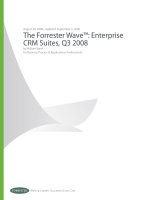Tài liệu The Finder Toolbar ppt
Bạn đang xem bản rút gọn của tài liệu. Xem và tải ngay bản đầy đủ của tài liệu tại đây (31.52 KB, 6 trang )
4.4. The Finder Toolbar
At the top of every Finder window is a small set of function icons, all in a gradientgray
row (Figure 4-6
). The first time you run Mac OS X 10.5, you'll find only these icons on
the toolbar:
•
Back, Forward. The Finder works something like a Web browser. Only a single
window remains open as you navigate the various folders on your hard drive.
Figure 4-6. If you -click the upper-right toolbar button repeatedly, you
cycle through six combinations of large and small icons and text labels.
(Three examples are shown here.) Tip: This same -clicking business
cycles through the same toolbar variations in Mail, Preview, and other
programs that have toolbars.
The Back button ( ) returns you to whichever folder you were just looking at.
(Instead of clicking, you can also press -[, or choose Go Back—
particularly handy if the toolbar is hidden,as described below.)
The Forward button ( ) springs to life only after you've used the Back button.
Clicking it (or pressing -]) returns you to the window you just backed out of.
•
View controls. The four tiny buttons next to the button switch the current
window into icon, list, column, or Cover Flow view, respectively (Section 1.2.12
).
And remember, if the toolbar is hidden, you can get by with the equivalent
commands in the View menu at the top of the screen—or by pressing -1,
-2, -3,or -4 (for icon, list, column, and Cover Flow view, respectively).
•
QuickLook. The eyeball icon opens the Quick Look preview for a highlighted icon
(or group of them); see Section 1.8
.
•
Action ( ). You can read all about this context-sensitive pop-up menu on
page77
•
Search bar. This little round-ended text box is yet another entry point for the
Spotlight feature described in Chapter 3
. It's a handy way to search your Mac for
some file, folder, disk, or program.
4.4.1. Removing or Shrinking the Toolbar
Between the toolbar, the Dock, the Sidebar, and the large icons of Mac OS X, it almost
seems like there's an Apple conspiracy to sell big screens.
Fortunately, the toolbar doesn't have to contribute to that impression. You can hide it
with one click—on the white, oval "Old Finder Mode" button (Section 1.2.10
). You can
also hide the toolbar by choosing View Hide Toolbar or pressing Option- -T.(The
same keystroke, or choosing View Show Toolbar, brings it back.)
But you don't have to do without the toolbar altogether. If its consumption of screen
space is your main concern, you may prefer to collapse it—to delete the pictures but
preserve the text buttons.
The trick is to -click the Old Finder Mode button. With each click, you make the
toolbar take up less vertical space, cycling through six variations of shrinking icons,
shrinking text labels, and finally labels without any icons at all (Figure 4-6
).
There's a long way to adjust the icon and label sizes, too: Choose View Customize
Toolbar (or Option- click the Old Finder Mode button). As shown in Figure 4-7
, the
dialog box that appears offers a Show pop-up menu at the bottom. It lets you choose
picture-buttons, Icon Only, or, for the greatest space conservation, Text Only. You can
see the results without even closing the dialog box.
Click Done or press Enter to make your changes stick.
Note: In Text Only mode, the four View buttons are replaced by a little pop-up menu
called View. Furthermore, the Search bar turns into a one-word button called Search.
Clicking it brings up the Spotlight window (Section 3.2
).
4.4.2. Adding Your Own Icons to the Toolbar
Mac OS X not only offers a collection of beautifully designed icons for alternate (or
additional) toolbar buttons, but makes it easy for you to add anythingto the toolbar,
turning the toolbar into a supplementary Dock or Sidebar. This is great news for people
who miss having their Home and Applications folder icons at the top of the window, as
they were in early Mac OS X versions, or for anyone who's run out of space for stashing
favorite icons in the Dock or the Sidebar. (Of course, if that's your problem, you need a
bigger monitor.)
4.4.2.1. Apple's toolbar-icon collection
As noted above, the first step in tweaking the toolbar is choosing View Customize
Toolbar. The window shown in Figure 4-7
appears.
Tip: There's a great secret shortcut for opening the Customize Toolbar window: Option-
-click the Old Finder Mode button that appears in the upper-right corner of every
Finder window.
Figure 4-7. While this window is open, you can add icons to the toolbar by dragging
them into place from the gallery before you. You can also remove icons from the
toolbar by dragging them up or down off the toolbar. Rearrange the icons by
dragging them horizontally.
This is your chance to rearrange the existing toolbar icons or delete the ones you don't
use. You can also add any of Apple's buttons to the toolbar by dragging them from the
"gallery" onto the toolbar itself. The existing icons scoot out of your cursor's way, if
necessary.
Most of the options in the gallery duplicate the functions of menu commands. Here are a
few that don't appear on the standard toolbar:
•
Path. Most of the gallery elements are buttons, but this one creates a pop-up menu
on the toolbar. When clicked, it reveals (and lets you navigate) the hierarchy—the
path—of folders that you open to reach whichever window is open. (Equivalent:
-clicking a window's title, as described on Section 1.2.3
.)
•
Eject. This button ejects whichever disk or disk image is currently highlighted.
(Equivalent: The File Eject command, or holding down the key on your
keyboard.)
•
Burn. This button burns a blank CD or DVD with the folders and files you've
dragged onto it. (Equivalent: The File Burn Disc command.)
•
Customize. This option opens this customizing window that you're already
examining. (Equivalent: The View Customize Toolbar command.)
•
Separator. This gallery icon doesn't actually do anything when clicked. It's
designed to set apart groups of toolbar icons. (For example, you might want to
segregate your folder buttons, such as Documents and Applications, from your
function buttons, such as Delete and Connect.) Drag this dotted line between two
existing icons on the toolbar.
•
Space. By dragging this mysterious-looking item into the toolbar, you add a gap
between it and whatever icon is to its left. The gap is about as wide as one icon.
(The fine, dark, rectangular outline that appears when you drag it doesn't actually
show up once you click Done.)
•
Flexible Space. This icon, too, creates a gap between the toolbar buttons. But this
one expands as you make the window wider. Now you know how Apple got the
Search box to appear off to the right of the standard toolbar, a long way from its
clustered comrades to the left.
•
NewFolder. Clicking this button creates a new folder in whichever window you're
viewing. (Equivalent: the File New Folder command, or the Shift- -N
keystroke.)
•
Delete. This option puts the highlighted file or folder icons into the Trash.
(Equivalent: the File Move to Trash command, or the -Delete keystroke.)
•
Connect. If you're on a home or office network, this opens the Connect to Server
dialog box (see Section 13.3.2
) so that you can tap into another computer.
(Equivalent: The Go Connect to Server command, or -K.)
•
Get Info. This button opens the Get Info window (Section 2.7) for whatever's
highlighted.
•
iDisk. The iDisk is your own personal 5-gigabyte virtual hard drive on the
Internet. It's your private backup disk, stashed at Apple, safe from whatever fire,
flood, or locusts may destroy your office. Of course, you already know this,
because you're paying $100 per year for the privilege (see Section 18.6
).
In any case, you can bring your iDisk's icon onto the screen simply by clicking this
toolbar icon.
•
Search. This item represents the Spotlight search bar described in Chapter 3.
•
Drag the default set. If you've made a mess of your toolbar, you can always
reinstate its original Apple arrangement by dragging this rectangular strip directly
upward onto your toolbar.
Note: If a window is too narrow to show all the icons on the toolbar, the right end of the
toolbar sprouts a >> symbol. Click it for a pop-up menu that names whichever icons don't
fit at the moment. (You'll find this toolbar behavior in many Mac OS X programs, not
just the Finder: iPhoto, Safari, Mail, Address Book, and so on.)
4.4.2.2. Adding your own stuff
Millions of Mac fans will probably trudge forward through life using the toolbar to hold
the suggested Apple function buttons, and the Sidebar to hold the icons of favorite
folders, files, and programs. They may never realize that you can drag any icons at all
onto the toolbar—files, folders, disks, programs, or whatever—to turn them into one-
click buttons.
In short, you can think of the Finder toolbar as yet another Dock or Sidebar (Figure 4-8
).
Figure 4-8. You don't need to choose View Customize Toolbar to add your own
icons to the toolbar. Just drag them from the desktop or any folder window directly
onto the toolbar, at any time. Pause with your cursor on the toolbar for a moment
before releasing the icon.
4.4.3. Rearranging or Removing Toolbar Icons
You can drag toolbar icons around, rearranging them horizontally, by pressing as
you drag. Taking an icon off the toolbar is equally easy. While pressing the key, just
drag the icon clear away from the toolbar. It vanishes in a puff of cartoon smoke.
If the Customize Toolbar sheet is open, you can perform either step without the key.









